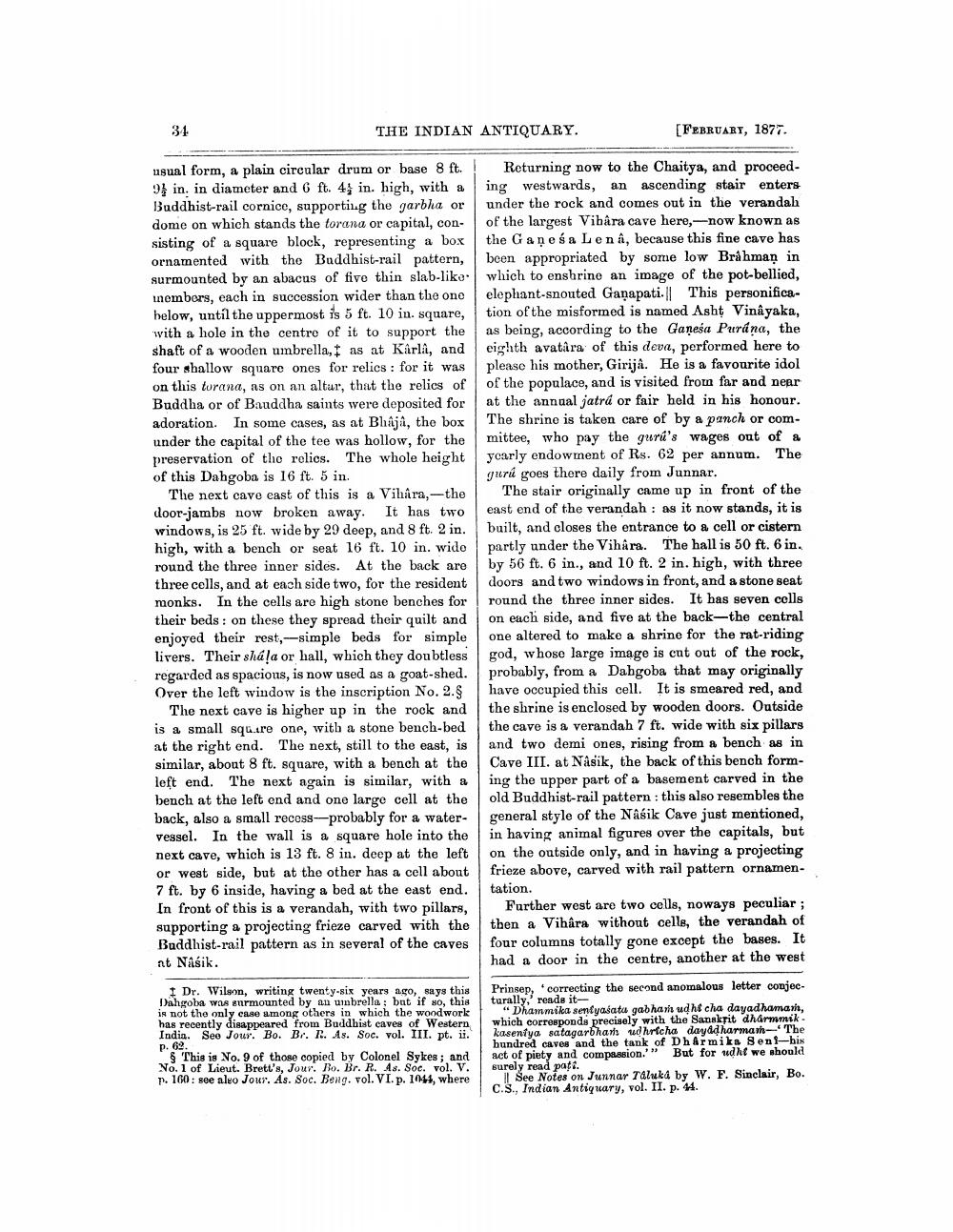________________
31
THE INDIAN ANTIQUARY.
[FEBRUARY, 1877.
usual form, a plain circular drum or base 8 ft. 9 in. in diameter and 6 ft. 4; in. high, with a Buddhist-rail cornice, supporting the garbha or dome on which stands the torana or capital, consisting of a square block, representing a box ornamented with the Buddhist-rail pattern, surmounted by an abacus of five thin slab-like. inembors, each in succession wider than the one helow, until the uppermost is 5 ft. 10 in. square, with a hole in the centre of it to support the shaft of a wooden umbrella, I as at Karla, and four shallow square ones for relics : for it was on this turana, as on an altar, that the relics of Buddha or of Bauddha saints were deposited for adoration. In some cases, as at Bhaja, the box under the capital of the tee was hollow, for the preservation of the relics. The whole height of this Dahgoba is 16 ft. 5 in.
The next cave cast of this is a Vihara,-the door-jambs now broken away. It has two windows, is 25 ft. wide by 29 deep, and 8 ft. 2 in. high, with a bench or seat 16 ft. 10 in. wide round the three inner sides. At the back are three cells, and at each side two, for the resident monks. In the cells are high stone benches for their beds : on these they spread their quilt and enjoyed their rest,--simple beds for simple livers. Their sháļa or hall, which they doubtless regarded as spacious, is now used as a goat-shed. Over the left window is the inscription No. 2.9
The next cave is higher up in the rock and is a small squ..re one, with a stone bench-bed at the right end. The next, still to the east, is similar, about 8 ft. square, with a bench at the left end. The next again is similar, with a bench at the left end and one large cell at the back, also a small recoss-probably for a watervessel. In the wall is a square hole into the next cave, which is 13 ft. 8 in. deep at the left or west side, but at the other has a cell about 7 ft. by 6 inside, having a bed at the east end. In front of this is a verandah, with two pillars, supporting a projecting frieze carved with the Buddhist-rail pattern as in several of the caves nt Nasik.
Returning now to the Chaitya, and proceeding westwards, an ascending stair enters under the rock and comes out in the verandah of the largest Vihara cave here, now known as the Ganesa Lenâ, because this fine cave has been appropriated by some low Brahman in which to enshrine an image of the pot-bellied, elephant-snouted Ganapati.| This personification of the misformed is named Asht Vinayaka, as being, according to the Ganesa Purána, the eighth avatars of this deva, performed here to please his mother, Girija. He is a favourite idol of the populace, and is visited from far and near at the annual jatrů or fair held in his honour. The shrine is taken care of by a panch or committee, who pay the guri's wages out of a yearly endowment of Rs. 62 per annum. The gurú goes there daily from Junnar.
The stair originally came up in front of the east end of the verandah : as it now stands, it is built, and closes the entrance to a cell or cistern partly under the Vihara. The hall is 50 ft. 6 in. by 56 ft. 6 in., and 10 ft. 2 in. high, with three doors and two windows in front, and a stone sea round the three inner sides. It has seven cells on each side, and five at the back-the central one altered to make a shrine for the rat-riding god, whose large image is cut out of the rock, probably, from a Dabgoba that may originally have occupied this cell. It is smeared red, and the shrine is enclosed by wooden doors. Outside the cave is a verandah 7 ft. wide with six pillars and two demi ones, rising from a bench as in Cave III. at Násik, the back of this bench forming the upper part of a basement carved in the old Buddhist-rail pattern : this also resembles the general style of the Nášik Cave just mentioned, in having animal figures over the capitals, but on the outside only, and in having a projecting frieze above, carved with rail pattern ornamentation.
Further west are two cells, noways peculiar; then a Vihara without cells, the verandah of four columns totally gone except the bases. It had a door in the centre, another at the west
1 Dr. Wilson, writing twenty-six years ago, says this Dahgoba was surmounted by an unbrella; but if so, this is not the only case among others in which the woodwork has recently disappeared from Buddhist caves of Western India. See Jouy. Bo. Br. R. As. Soc. vol. III. pt. ii. p. 69.
$ This is No. 9 of those copied by Colonel Sykes; and No. 1 of Lieut. Brett's, Jour. Bo. Br. R.As. Soc. vol. V. . 160: see alvo Jour. As. Soc. Beng. vol. VI.p. 1044, where
Prinsep, correcting the second anomalous letter conjecturally,' reads it
"Dhammika sentyasata gabhar udhi cha dayadhaman. which corresponds precisely with the Sanskrit dharmmik kasentya satagarbharts udhrfcha dayadharmath- The hundred caves and the tank of Dharmiks Seni-bis act of piety and compassion.'" But for udht we should surely read pati.
| See Notes on Junnar Talukd by W. F. Sinclair, Bo. C.S., Indian Antiquary, vol. II. p. 44.




